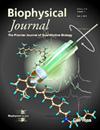Nanoscale Clustering and Dynamics of Phosphatidylinositol 4,5-Bisphosphate in an Immune Cell Model.
IF 3.2
3区 生物学
Q2 BIOPHYSICS
引用次数: 0
Abstract
Mast cells mediate their immuno- and neuro-modulatory effects by releasing granules containing bioactive substances. Phosphatidylinositol 4,5-bisphosphate (PIP2), enriched at the plasma membrane (PM), is a key signaling lipid involved in numerous physiological functions including the calcium entry needed for antigen stimulated mast cell degranulation. However, functional nanoscale PIP2 clustering and dynamics have not been previously investigated in immune cells. Using the pleckstrin homology domain from PLCδ (PH) tagged with photoswitchable fluorescent protein Dendra2, clustering was revealed in the mast cell model RBL-2H3, both fixed and live. We also discovered that live RBL-2H3 cells have PH clusters which evolve over timescales of ∼100s. Additionally, the distribution of PIP2, and specifically PIP2 clusters themselves, are disrupted upon addition of the cationic, lipidic drug cetylpyridinium chloride (CPC). CPC led to smaller, less dense, and more circular clusters. Furthermore, PH molecular mobility increased after the addition of CPC, suggesting interference of this drug with PH binding to PIP2. In addition to this pharmacological relevance, the physiology of PIP2 clusters during functional stimulation by antigen was investigated. Antigen stimulation led to increased cluster size, which was counteracted by CPC. In live cells, PH density outside clusters was altered by CPC but not by antigen. CPC increased the proportion of regions of high-density PH compared to all other regions of the PM. While PH diffusion was, interestingly, not affected by antigen, it was increased by CPC, particularly in lower density regions. Under all live cell dynamics observed, PH demonstrated confinement which were consistent with simulated diffusion within potential wells with an elliptical shape. These findings illuminate the nanoscale behavior of PIP2 in immune cells and the correlation of that behavior with cell function.免疫细胞模型中磷脂酰肌醇4,5-二磷酸的纳米级聚类和动力学。
肥大细胞通过释放含有生物活性物质的颗粒介导其免疫和神经调节作用。磷脂酰肌醇4,5-二磷酸(PIP2)富集于质膜(PM),是一种关键的信号脂质,参与许多生理功能,包括抗原刺激肥大细胞脱颗粒所需的钙进入。然而,在免疫细胞中,功能纳米级PIP2聚类和动力学尚未被研究过。利用可光切换荧光蛋白Dendra2标记的PLCδ (PH)的pleckstrin同源结构域,在固定和活的肥大细胞模型RBL-2H3中发现了聚类。我们还发现,活的RBL-2H3细胞具有PH团,其时间尺度为~ 100s。此外,PIP2的分布,特别是PIP2簇本身,在加入阳离子脂质药物氯化十六烷基吡啶(CPC)后被破坏。CPC导致了更小、密度更低、更圆的集群。此外,加入CPC后PH分子迁移率增加,提示该药物干扰PH与PIP2的结合。除了这种药理学相关性外,还研究了PIP2簇在抗原功能刺激下的生理学。抗原刺激导致簇大小增加,而CPC抵消了这一作用。在活细胞中,簇外的PH密度被CPC改变,而不受抗原的影响。与PM的所有其他区域相比,CPC增加了高密度PH区域的比例。有趣的是,虽然PH扩散不受抗原的影响,但CPC增加了PH扩散,特别是在低密度区域。在观察到的所有活细胞动力学中,PH表现出约束,这与模拟的椭圆势阱内扩散一致。这些发现阐明了PIP2在免疫细胞中的纳米级行为以及这种行为与细胞功能的相关性。
本文章由计算机程序翻译,如有差异,请以英文原文为准。
求助全文
约1分钟内获得全文
求助全文
来源期刊

Biophysical journal
生物-生物物理
CiteScore
6.10
自引率
5.90%
发文量
3090
审稿时长
2 months
期刊介绍:
BJ publishes original articles, letters, and perspectives on important problems in modern biophysics. The papers should be written so as to be of interest to a broad community of biophysicists. BJ welcomes experimental studies that employ quantitative physical approaches for the study of biological systems, including or spanning scales from molecule to whole organism. Experimental studies of a purely descriptive or phenomenological nature, with no theoretical or mechanistic underpinning, are not appropriate for publication in BJ. Theoretical studies should offer new insights into the understanding ofexperimental results or suggest new experimentally testable hypotheses. Articles reporting significant methodological or technological advances, which have potential to open new areas of biophysical investigation, are also suitable for publication in BJ. Papers describing improvements in accuracy or speed of existing methods or extra detail within methods described previously are not suitable for BJ.
 求助内容:
求助内容: 应助结果提醒方式:
应助结果提醒方式:


